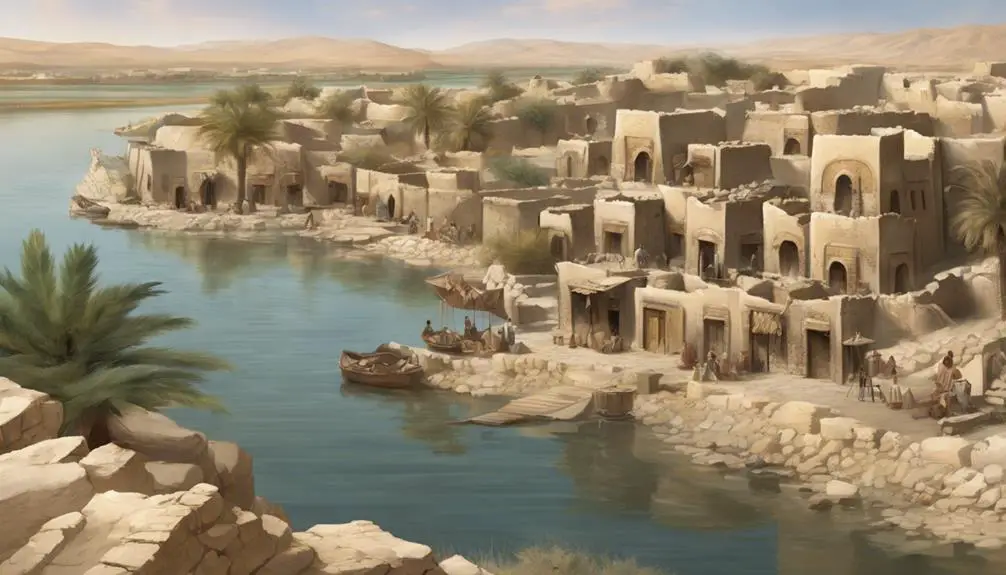Gain insights into the enigmatic Tel Abib, a biblical site that holds secrets of ancient exiles and prophetic revelations waiting to be uncovered.

Tel Abib in the Bible
Imagine you're walking through the ancient ruins of Tel Abib, feeling the weight of history beneath your feet. This site, mentioned in the Bible, served as a poignant reminder of the Israelite exile to Babylon. You might wonder about the stories of those who lived through this tumultuous period and how their experiences shaped the spiritual landscape of future generations.
As we explore the historical context of Tel Abib and its significance in biblical prophecy, you'll find that the lessons drawn from the Israelites' exile carry profound implications for understanding faith and endurance. Let's uncover what this ancient site can teach us today.
Key Takeaways
- Tel Abib, mentioned in the Book of Ezekiel, serves as a backdrop for significant biblical prophecies.
- Its archaeological findings provide insights into the daily lives and spiritual resilience of the exiled Judean community.
- The location was pivotal for understanding the impact of the Babylonian exile on Jewish faith and identity.
- Tel Abib's historical and spiritual significance highlights the themes of judgment, hope, and restoration in biblical narratives.
The Historical Context of Tel Abib

Tel Abib, nestled by the Chebar Canal, served as a critical waypoint for exiled Judeans during the Neo-Babylonian Empire. Its geographical location, strategically positioned along this ancient waterway, made it a focal point for the movements and settlement patterns of displaced communities. You might wonder how current scholars have pieced together the narrative of Tel Abib, given the passage of centuries. The answer lies in the meticulous examination of archaeological evidence and historical texts.
The archaeological evidence unearthed from Tel Abib and its surroundings offers you a tangible connection to the past. These findings, ranging from pottery shards to remnants of ancient structures, provide critical insights into the daily lives, economic activities, and social structures of the Judean exiles. They also help to map out the broader geopolitical landscape of the Neo-Babylonian Empire, illustrating how Tel Abib fit into a complex network of trade routes, political alliances, and cultural exchanges.
Moreover, the geographical location of Tel Abib, by the Chebar Canal, isn't only significant for understanding the logistics of exile and settlement but also hints at the adaptive strategies employed by the Judean community in response to their new environment. The proximity to water would have been crucial for agriculture, trade, and sustaining a population far from their homeland.
In analyzing Tel Abib's historical context, you're drawn into a narrative that transcends mere facts and figures. The archaeological evidence and the significance of its geographical location weave together a story of survival, adaptation, and resilience. This deeper understanding challenges you to appreciate the complex interplay between geography, history, and human endeavor in the ancient world.
Tel Abib in Biblical Prophecy

In exploring the role of Tel Abib within biblical prophecy, you'll find its mention in the Book of Ezekiel not only intriguing but deeply significant for understanding the prophetic landscape of the time. This location serves as a backdrop for Ezekiel's visions and messages from God, highlighting its importance in the narrative of exile and divine communication.
Modern archaeology has shed light on the historical and cultural context of Tel Abib, allowing for a more nuanced understanding of its place in biblical history. These discoveries contribute to the prophetic interpretation of Ezekiel's writings, offering insights into the physical and spiritual conditions of the exiles living there. The archaeological findings corroborate the biblical narrative, providing tangible evidence of the community's existence and its struggles during this period.
Furthermore, the prophetic interpretation of events surrounding Tel Abib emphasizes the role of prophecy in shaping the identity and destiny of the Israelites in exile. Ezekiel's prophecies, delivered from Tel Abib, address themes of judgment, hope, and restoration, reflecting the broader theological and eschatological views of the time. His visions and messages, deeply rooted in the specific context of Tel Abib, resonate with universal themes of divine justice and mercy.
The Exile to Babylon Explained

Understanding the significance of Tel Abib within biblical prophecy sets the stage for a deeper exploration of the Exile to Babylon, a pivotal event that reshaped the course of Jewish history. This episode, marked by Jerusalem's fall and the subsequent deportation of the Judean elite, invites a nuanced analysis of Nebuchadnezzar's strategy and its far-reaching implications.
Nebuchadnezzar, the Babylonian king, implemented a calculated strategy aimed at dismantling the socio-political structure of conquered territories, with Jerusalem's fall in 586 BCE serving as a prime example. By targeting the elite—royalty, priests, prophets, and skilled craftsmen—for deportation to Babylon, he sought not only to quell potential rebellions but also to assimilate these groups into Babylonian society, thereby diluting their cultural identity and weakening their ties to their homeland. This approach ensured the subjugation of the Judean population and the consolidation of Babylonian control.
The Exile didn't merely represent a physical relocation; it was a profound cultural and spiritual dislocation that challenged the exiles' understanding of their identity, faith, and relationship with their God. Stripped of their temple, monarchy, and land—key pillars of their religious and national identity—the exiles were forced to reconceptualize their community and faith in the foreign setting of Babylon.
Jerusalem's fall and the subsequent Babylonian Exile thus stand as a watershed moment in Jewish history, catalyzing significant theological, cultural, and social transformations. These events underscore the adaptive resilience of the Jewish people and the evolution of their religious practices and beliefs in response to exile and adversity.
Spiritual Significance of Tel Abib

Amid the tumult of the Babylonian Exile, Tel Abib emerges as a symbol of spiritual resilience for the displaced Judean community. This significance isn't merely a historical footnote but is amplified through archaeological discoveries that provide tangible links to this past. These finds, consisting of artifacts and remnants of ancient settlements, serve as silent witnesses to the perseverance of faith amidst adversity.
The spiritual significance of Tel Abib extends beyond its historical context, offering modern parallels that resonate with contemporary experiences of displacement and cultural dislocation. Just as the Judeans struggled to maintain their spiritual identity in a foreign land, today's diaspora communities face similar challenges. Tel Abib's story underscores the importance of preserving spiritual traditions and beliefs, even in the most trying circumstances.
Furthermore, Tel Abib stands as a testament to the power of collective memory in sustaining a community's spiritual life. The act of remembering, as facilitated by the recounting of Tel Abib's story in religious texts, plays a crucial role in fostering a sense of continuity and belonging among displaced peoples. This historical memory, enriched by archaeological discoveries, becomes a source of strength and inspiration, bridging the gap between past and present.
Lessons From the Israelites' Exile

Reflecting on the spiritual resilience of Tel Abib, we can extract valuable lessons from the Israelites' exile regarding the endurance of faith and identity under duress. The period of exile wasn't merely a time of punishment but also an era of profound transformation for the Israelites. It offers timeless insights into how communities can maintain their core values while navigating the challenges of cultural integration and the consequences of rebellion.
- Enduring Faith Under Pressure: The Israelites' ability to maintain their religious practices away from their homeland showcases the power of faith to provide strength and cohesion in foreign environments.
- Cultural Integration Without Loss of Identity: Their story demonstrates the delicate balance between integrating into a new culture and retaining one's distinct identity. It's a testament to the Israelites' adaptability and resilience.
- Learning From Rebellion Consequences: The exile serves as a stark reminder of the repercussions of turning away from foundational values and the importance of communal adherence to spiritual and moral principles.
- Preservation of Community: Despite the physical dislocation, the Israelites managed to keep their community intact, highlighting the importance of communal support systems in times of crisis.
- Inter-generational Transmission of Values: The exile period emphasizes the role of oral tradition and education in preserving a community's beliefs and practices for future generations.
These lessons from the Israelites' exile in Tel Abib remain highly relevant, offering insights into maintaining identity and faith amidst adversity and change.
Reflections on Faith and Endurance

In exploring the concept of faith and endurance, it's evident that these qualities aren't only foundational but also imperative for navigating through life's most challenging periods. The historical context of Tel Abib, as presented in the Bible, mirrors this assertion, offering a profound reflection on the enduring nature of faith amidst adversity. The narrative encapsulates not just a physical journey but also a spiritual odyssey, highlighting the intricate relationship between faith dynamics and the human spirit's resilience.
This exploration sheds light on the essence of modern resilience. In today's context, the principles derived from Tel Abib resonate deeply, suggesting that the endurance of faith isn't static but evolves with time. The dynamism of faith dynamics becomes apparent when faced with contemporary challenges, where the essence of belief and perseverance is tested. This evolution is critical in understanding how faith operates as a catalyst for resilience, enabling individuals to withstand and adapt to the ever-changing landscape of life.
Moreover, the reflection on faith and endurance prompts a reevaluation of one's relationship with these concepts. It encourages a deeper introspection into how faith is nurtured and sustained, especially in moments of profound difficulty. The narrative of Tel Abib serves as a timeless reminder that faith, coupled with endurance, forms the bedrock of not only surviving but thriving amidst trials.
Frequently Asked Questions
How Has Modern Archaeology Contributed to Our Understanding of Tel Abib and Its Exact Location?
Modern archaeology's advanced excavation methods and artifact dating techniques have significantly enhanced our understanding of Tel Abib's exact location. By analyzing soil layers and dating artifacts, archaeologists are able to trace back the settlement's timeline, providing a clearer picture of its historical context.
This scholarly approach hasn't only pinpointed Tel Abib's location more accurately but has also enriched our comprehension of the site's historical significance and its inhabitants' lifestyles.
Are There Any Cultural or Religious Practices Today That Trace Their Origins Back to the Time of the Israelites' Settlement in Tel Abib?
You're looking into whether current cultural or religious practices have roots in ancient Israelite settlement traditions. While direct links can be elusive, modern festivals and ancestral diets often reveal echoes of these early practices.
Scholars suggest that some rituals and food choices today may trace back to this period, highlighting the enduring influence of ancient traditions on contemporary life.
These connections offer a fascinating glimpse into how past practices shape present customs.
How Has the Interpretation of Tel Abib's Role in Biblical Prophecy Evolved Among Different Christian Denominations Over Time?
You're exploring how prophecy interpretations regarding Tel Abib have shifted among Christian groups. Denominational views vary widely; some see its mention as symbolic, reflecting spiritual exile and redemption, while others interpret it more historically, focusing on the literal events and locations.
This evolution reflects broader theological trends, where some denominations emphasize metaphorical readings of scripture, and others adhere to a more literal understanding, showing the dynamic nature of biblical interpretation over time.
Can Any Parallels Be Drawn Between the Israelites' Experience in Tel Abib and Other Historical Exiles or Diasporas in Human History?
You're exploring how historical exiles mirror each other across time. Imagine nations adrift, their identities challenged by cultural assimilation, political implications swirling like dust in their wake.
This analysis reveals striking parallels: the forced migrations, the struggle to maintain cultural identity amidst overpowering host societies, and the political chess games played on the backs of the displaced.
It's a rich tapestry of human history, repeating motifs of resilience and adaptation.
What Impact Did the Narrative of Tel Abib Have on Jewish and Christian Art and Literature Throughout the Centuries?
You'll find that the narrative you're exploring has significantly influenced Jewish and Christian art and literature. Artistic motifs and literary themes rooted in this story have permeated works over the centuries, reflecting its deep impact.
Analyzing these manifestations, you'll notice a rich tapestry of interpretations and expressions, showcasing the narrative's ability to inspire across various mediums.
This scholarly observation highlights the enduring relevance and transformative power of the story in question.
Conclusion
In your journey through the biblical landscape of Tel Abib, you've traversed historical terrain, delved into prophecy, and explored spiritual dimensions.
You've seen how exile serves as both a physical displacement and a spiritual awakening. As you reflect on the Israelites' trials, remember, their story is a testament to faith's endurance and resilience.
Just as they learned from their exile, so too can you find strength in adversity, understanding in loss, and hope in renewal. This narrative isn't just history; it's a guide for enduring faith.


Sign up